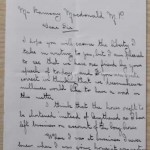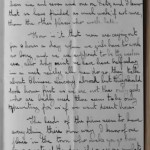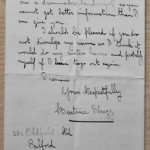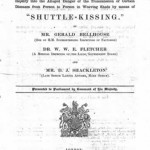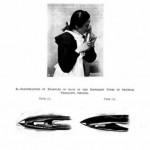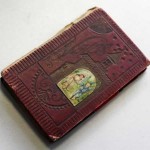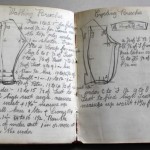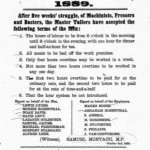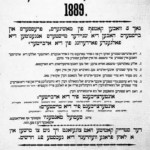Sweated Labour was typified by long working hours, poor working conditions (‘sweatshops’) with low pay. In 1906 the Daily Mail sponsored an exhibition exposing the sweated conditions of many workers. Photographs were displayed in the exhibition along with other trades, highlighting the stark contrast between the lives of working women and those who consumed fashion. The exhibition raised awareness among middle-class reformers who campaigned for a minimum wage.
-
Sweated Garment Workers print by Gertrude Elias (1913-1998)
Elias was an Industrial Educationist. She was concerned about the exploitation of garment workers, particularly those who worked in rural factories and did not know of a local union.
-
Letter from Beatrice Skegg to Ramsey MacDonald MP (Page 1) (1906)
This letter from a Salford ex-tailoress is a response to Macdonald’s speech calling for shorter working hours. It explains working conditions and hours of dressmakers and milliners. [Transcript]
-
Letter from Beatrice Skegg to Ramsey MacDonald MP (Page 2) (1906)
[Transcript]
-
Letter from Beatrice Skegg to Ramsey MacDonald MP (Page 3) (1906)
[Transcript]
-
Man kissing shuttle
This was the method of re-threading new bobbins into weaving shuttles by pressing your mouth against it and make a sucking noise. The process of kissing the shuttle would be repeated at least 300 times per day and also caused the inhalation of dust and dirt amongst other things.
-
Shuttle-kissing Inquiry (1912)
This Home Office Inquiry detailed the industrial hazards of re-threading kissing shuttles, a practice which would not be outlawed until 1952 despite causing the spread of disease.
-
Shuttle-kissing Inquiry (1912)
Appendix
-
Factory Machinists at Van Heusen Factory
A typical machinists factory, the Van Heusen factory produced high quality shirts.
-
Group of women baby’s boot and shoe making (1906)
In the late 19th Century, economic depression encouraged factories to outsource cheap piecework. Factory tailors and tailoresses opposed homeworkers joining their union, fearing it would bring piece rates down.
-
Jewish Tailors (Before 1914)
Late 19th Century Jewish immigrants were restricted to working in unskilled and semi-skilled occupations, and many became tailors. They faced sweated and unstable working conditions and sometimes hostile employers.
-
Tailor’s notebook (About 1907)
A notebook kept by a tailor, containing various patterns and plans for garments.
-
Tailor’s notebook (About 1907)
-
‘My Day’s Work by a Lancashire Weaver’ from Labour Woman (February 1933)
Labour Woman was the Labour Party’s women’s magazine from 1913-1971, covering votes for women as well as various campaigns with women’s interests in mind. It ran a series of articles on the working day of different women.
-
Rules To Be Observed By the Hands Employed in This Mill (1851)
Working conditions in Water-Foot mill, reflecting the experiences of many factory workers in strict industrial environments.
-
Men’s coat makers (1906)
After the invention of the Singer sewing machine, working from home was common in the tailored trades. Workers would often finish ready to wear garments as a necessary way to supplement the household income, paying hire for the machine. A 1906 survey showed that more than half the women who were homeworkers were married to poorly paid husbands, and the rest were widowed with young children.
-
Tailor’s Strike poster (1889) English version
East London tailors went on strike for five weeks against sweated conditions. Leaflets were printed in English and Yiddish and encouraged 10,000 workers to take action, and eventually a 10 ½ hour day and a limit on overtime was accomplished.
-
Tailor’s Strike poster (1889) Yiddish version
-
Discriminate against Inferior Unclean Sweat-shop Working leaflet (About 1900)
This American advert depicts a man opening his jacket showing the label advertising it as a union made garment which would be a selling point.
-
Cotton weavers, Barclay Home for the Blind at Brighton, Sussex (About 1900)
The Barclay Home for the Blind began a weaving industry, providing industrial training for blind women.
All of the images and texts published in this virtual exhibition are for private use only and not for copying, reproduction or publication. They are low resolution images only. The copyright holder for these digital images is the People’s History Museum, except for the Tailor’s Notebooks and the National Union of Tailors and Garment Workers (NUTGW) pamphlet which have kindly been contributed by the Working Class Movement Library, Salford. Copyright of the original artwork, photographs or products may be held by the artist, maker, photographer or agent. By choosing to view the collections via this website you have accepted these conditions.
We would like to thank Ingrid Francis (MA Museum Studies, Newcastle University) who has worked on the construction of this virtual exhibition as part of her placement at the People’s History Museum. We would also like to thank the National Co-operative Archives, People’s History Museum and the Working Class Movement Library for permitting items from their collection to be used in this exhibition.

